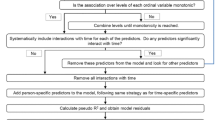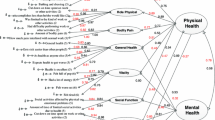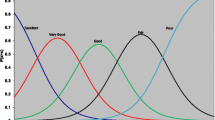Abstract
Purpose
Response shift (RS) may mask true change in health-related quality of life in longitudinal studies. People with chronic conditions may experience RS as they adapt to their disease, but it is unknown whether fluctuations in disease activity will influence the presence of RS. The study purpose was to test for RS in individuals with inflammatory bowel disease (IBD), a condition characterized by periods of symptom flares and remission.
Methods
Data were from the Manitoba IBD Cohort Study (N = 388). Multi-group confirmatory factor analysis (MG-CFA) and a RS detection method based on structural equation modeling were used to test for reconceptualization, reprioritization, and recalibration RS in participants with consistent active, consistent inactive, and inconsistent disease activity over a 6-month period on the SF-36.
Results
The MG-CFA revealed that a weak invariance model with equal factor loadings across groups was the best fit to the baseline SF-36 data. Reconceptualization, uniform recalibration, and non-uniform recalibration RS was detected in the consistent active group, but effect sizes were small. For the consistent inactive group, recalibration RS was observed and effect sizes were small to moderate. For the inconsistent disease activity group, small-to-moderate recalibration RS effects were observed. There was no evidence of reprioritization.
Conclusions
Individuals with a chronic disease may exhibit RS even if they are not actively experiencing symptoms on a consistent basis. Heterogeneity in the type and magnitude of RS effects may be observed in chronic disease patients who experience changes in disease symptoms.

Similar content being viewed by others
References
Sprangers, M. A., & Schwartz, C. E. (1999). Integrating response shift into health-related quality of life research: A theoretical model. Social Science and Medicine, 48, 1507–1515.
Barclay-Goddard, R., Epstein, J. D., & Mayo, N. E. (2009). Response shift: A brief overview and proposed research priorities. Quality of Life Research, 18, 335–346.
Oort, F. J., Visser, M. R. M., & Sprangers, M. A. G. (2005). An application of structural equation modeling to detect response shifts and true change in quality of life data from cancer patients undergoing invasive surgery. Quality of Life Research, 14, 599–609.
Schwartz, C. E., Sajobi, T. T., Lix, L. M., Quaranto, B. R., & Finkelstein, J. A. (2013). Changing values, changing outcomes: The influence of reprioritization response shift on outcome assessment after spine surgery. Quality of Life Research, 22, 2255–2264.
Schwartz, C. E., & Finkelstein, J. A. (2009). Understanding inconsistencies in patient-reported outcomes after spine treatment: Response shift phenomena. Spine Journal, 9, 1039–1045.
Razmjou, H., Yee, A., Ford, M., & Finkelstein, J. A. (2006). Response shift in outcome assessment in patients undergoing total knee arthroplasty. Journal of Bone and Joint Surgery, 88, 2590–2595.
Visser, M. R., Oort, F. J., van Lanschot, J. J., Velden, J., Kloek, J. J., Gouma, D. J., et al. (2013). The role of recalibration response shift in explaining bodily pain in cancer patients undergoing invasive surgery: An empirical investigation of the Sprangers and Schwartz model. Psychooncology, 22, 515–522.
Barclay-Goddard, R., King, J., Dubouloz, C. J., & Schwartz, C. E. (2012). Building on transformative learning and response shift theory to investigate health-related quality of life changes over time in individuals with chronic health conditions and disability. Archives of Physical Medicine and Rehabilitation, 93, 214–220.
O’Boyle, C. A., McGee, H., Hickey, A., O’Malley, K., & Joyce, C. R. (1992). Individual quality of life in patients undergoing hip replacement. Lancet, 339, 1088–1091.
Osborne, R. H., Hawkins, M., & Sprangers, M. A. (2006). Change of perspective: A measurable and desired outcome of chronic disease self-management intervention programs that violates the premise of preintervention/postintervention assessment. Arthritis and Rheumatism, 55, 458–465.
King-Kallimanis, B. L., Oort, F. J., Nolte, S., Schwartz, C. E., & Sprangers, M. A. (2011). Using structural equation modeling to detect response shift in performance and health-related quality of life scores of multiple sclerosis patients. Quality of Life Research, 20, 1527–1540.
Schwartz, C. E., Sprangers, M. A., Oort, F. J., Ahmed, S., Bode, R., Li, Y., et al. (2011). Response shift in patients with multiple sclerosis: An application of three statistical techniques. Quality of Life Research, 20, 1561–1572.
Lix, L. M., Graff, L. A., Walker, J. R., Clara, I., Rawsthorne, P., Rogala, L., et al. (2008). Longitudinal study of quality of life and psychological functioning for active, fluctuating, and inactive disease patterns in inflammatory bowel disease. Inflammatory Bowel Diseases, 14, 1575–1584.
Graff, L. A., Walker, J. R., Lix, L., Clara, I., Rawsthorne, P., Rogala, L., et al. (2006). The relationship of inflammatory bowel disease type and activity to psychological functioning and quality of life. Clinical Gastroenterology and Hepatology, 4, 1491–1501.
Bernklev, T., Jahnsen, J., Lygren, I., Henriksen, M., Vatn, M., & Moum, B. (2005). Health-related quality of life in patients with inflammatory bowel disease measured with the short form-36: Psychometric assessments and a comparison with general population norms. Inflammatory Bowel Diseases, 11, 909–918.
Iglesias-Rey, M., Barreiro-de, A. M., Caamano-Isorna, F., Rodriguez, I. V., Ferreiro, R., Lindkvist, B., et al. (2014). Psychological factors are associated with changes in the health-related quality of life in inflammatory bowel disease. Inflammatory Bowel Diseases, 20, 92–102.
Thirlby, R. C., Sobrino, M. A., & Randall, J. B. (2001). The long-term benefit of surgery on health-related quality of life in patients with inflammatory bowel disease. Archives of Surgery, 136, 521–527.
Bernstein, C. N., Rawsthorne, P., Cheang, M., & Blanchard, J. F. (2006). A population-based case control study of potential risk factors for IBD. American Journal of Gastroenterology, 101, 993–1002.
Maruish, M. (2011). User’s manual for the SF-36 health survey (3rd ed.). Lincoln: QualityMetric Inc.
Brazier, J. E., Harper, R., Jones, N. M., O’Cathain, A., Thomas, K. J., Usherwood, T., et al. (1992). Validating the SF-36 health survey questionnaire: New outcome measure for primary care. British Medical Journal, 305, 160–164.
Sainsbury, A., & Heatley, R. V. (2005). Review article: Psychosocial factors in the quality of life of patients with inflammatory bowel disease. Alimentary Pharmacology & Therapeutics, 21, 499–508.
Clara, I., Lix, L. M., Walker, J. R., Graff, L. A., Miller, N., Rogala, L., et al. (2009). The Manitoba IBD Index: Evidence for a new and simple indicator of IBD activity. American Journal of Gastroenterology, 104, 1754–1763.
Gregorich, S. E. (2006). Do self-report instruments allow meaningful comparisons across diverse population groups? Testing measurement invariance using the confirmatory factor analysis framework. Medical Care, 44, S78–S94.
Cheung, G. W., & Rensvold, R. B. (2002). Evaluating goodness-of-fit indexes for testing measurement invariance. Structural Equation Modeling, 9, 233–255.
Oort, F. J. (2005). Using structural equation modeling to detect response shifts and true change. Quality of Life Research, 14, 587–598.
Cohen, J. (1988). Statistical power analysis for the behavioral sciences. Hillsdale: Routledge Academic.
Kline, R. B. (2011). Principles and practice of structural equation modeling (3rd ed.). New York: The Guilford Press.
Tomarken, A. J., & Waller, N. G. (2003). Potential problems with “well fitting” models. Journal of Abnormal Psychology, 112, 578–598.
Rubin, D. B. (1987). Multiple imputation for nonresponse in surveys. New York: Wiley.
Asparouhov, T., & Muthen, B. (2006). Robust Chi square difference testing with mean and variance adjusted test statistics. Los Angeles: MPlus Web Notes.
Ware, J. E, Jr, Snow, K. K., Kosinski, M., & Gandek, B. (1993). SF-36 health survey: Manual and interpretation guide. Boston: The Health Institute, New England Medical Center.
Casati, J., & Toner, B. B. (2000). Psychosocial aspects of inflammatory bowel disease. Biomedicine & Pharmacotherapy, 54, 388–393.
Mayo, N. E., Scott, S. C., Dendukuri, N., Ahmed, S., & Wood-Dauphinee, S. (2008). Identifying response shift statistically at the individual level. Quality of Life Research, 17, 627–639.
Turnbull, G. K., & Vallis, T. M. (1995). Quality of life in inflammatory bowel disease: The interaction of disease-activity with psychosocial function. American Journal of Gastroenterology, 90, 1450–1454.
Casellas, F., Lopez-Vivancos, J., Badia, X., Vilaseca, J., & Malagelada, J. R. (2001). Influence of inflammatory bowel disease on different dimensions of quality of life. European Journal of Gastroenterology and Hepatology, 13, 567–572.
Borsboom, G. J., Korfage, I. J., Essink-Bot, M. L., & Duivenvoorden, H. J. (2007). The structural equation modeling technique did not show a response shift, contrary to the results of the then test and the individualized approaches. Journal of Clinical Epidemiology, 60, 426–427.
Donaldson, G. W. (2005). Structural equation models for quality of life response shifts: Promises and pitfalls. Quality of Life Research, 14, 2345–2351.
Barclay-Goddard, R., Lix, L. M., Tate, R., Weinberg, L., & Mayo, N. E. (2009). Response shift was identified over multiple occasions with a structural equation modeling framework. Journal of Clinical Epidemiology, 62, 1181–1188.
Schwartz, C. E., Ahmed, S., Sawatzky, R., Sajobi, T., Mayo, N., Finkelstein, J., et al. (2013). Guidelines for secondary analysis in search of response shift. Quality of Life Research, 22, 2663–2673.
Mayo, N. E., Scott, S. C., & Ahmed, S. (2009). Case management poststroke did not induce response shift: The value of residuals. Journal of Clinical Epidemiology, 62, 1148–1156.
Guilleux, A., Blanchin, M., Vanier, A., Guillemin, F., Falissard, B., Schwartz, C. E., et al. (2015). RespOnse Shift Algorithm in Item response theory (ROSALI) for response shift detection with missing data in longitudinal patient-reported outcome studies. Quality of Life Research, 24, 553–564.
Acknowledgments
LML is supported by a Manitoba Health Research Chair. RS is supported by a Canada Research Chair.
Funding
This study was funded by the Canadian Institutes of Health Research (Funding Reference #122110) and Research Manitoba.
Author information
Authors and Affiliations
Corresponding author
Ethics declarations
Conflict of interest
None of the authors has a conflict of interest to declare.
Ethical approval
All procedures performed in studies involving human participants were in accordance with the ethical standards of the University of Manitoba Health Research Ethics Board and with the 1964 Helsinki Declaration and its later amendments or comparable ethical standards.
Informed consent
Informed consent was obtained from all individual participants included in the Manitoba Inflammatory Bowel Disease Cohort Study.
Electronic supplementary material
Below is the link to the electronic supplementary material.
Rights and permissions
About this article
Cite this article
Lix, L.M., Chan, E.K.H., Sawatzky, R. et al. Response shift and disease activity in inflammatory bowel disease. Qual Life Res 25, 1751–1760 (2016). https://doi.org/10.1007/s11136-015-1188-z
Accepted:
Published:
Issue Date:
DOI: https://doi.org/10.1007/s11136-015-1188-z




